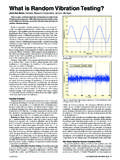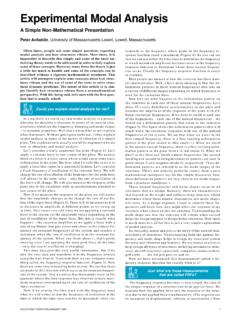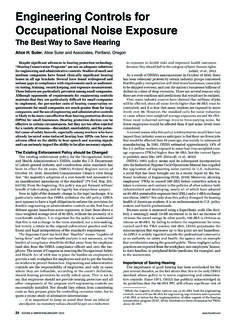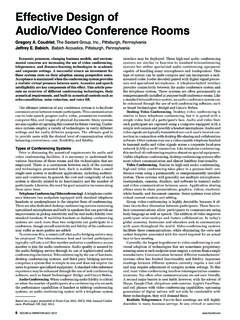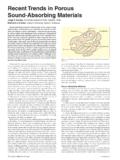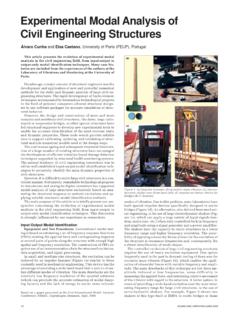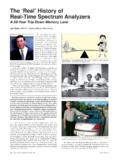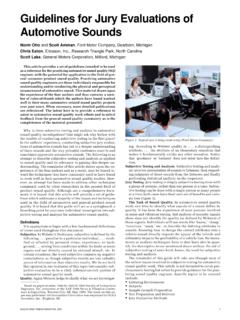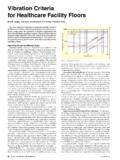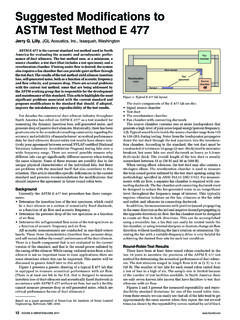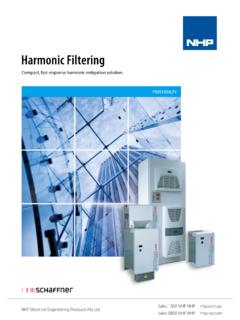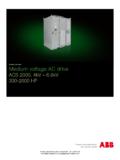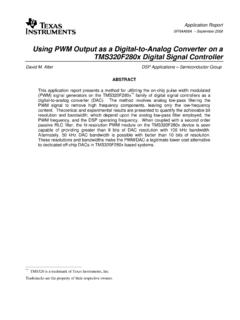Transcription of Applying the Inverse FFT for Filtering, Transient …
1 18 SOUND AND VIBRATION/AUGUST 2005 The discrete Fourier Transform (DFT) can be developedfrom the Fourier series, which results in the most useful formfor machinery diagnostics. This form presents the transformof an even number of data values as the amplitude and phaseof a set of (N/2 + 1) sine waves or N complex exponentials. Thispoint of view presents the Inverse DFT (IDFT) conceptuallyas the addition of correctly phased discrete complexexponentials. The Inverse Fast Fourier Transform (IFFT) isneeded to perform the add because of the economies it em-ploys. The complex exponentials defined by the DFT can beviewed as continuous, but when evaluated at times corre-sponding to the original data samples and added together, theyexactly duplicate the original data sequence.
2 The sum of thecomplex exponentials form a continuous band limited curveexactly passing through the data points. This article explainsthis point of view and applies it to Transient detection, filter-ing, resampling and bin Fourier Transform (FT) has a myriad of uses. Some ofthem are central to machinery diagnostics. Hidden periodicitiesare the key those repeated or cyclic parts of a machinery vi-bration signal. Their characteristics can be a clue for diagnos-ing machine condition. What is cyclic? It is a fabulous salesangle. Good pitch charlatans have been snowing us with it for-ever: .. I ve gone back and investigated the price of oobergoobers over the last couple of centuries and have noticed acyclic pattern, repeated maybe 12 or 13 times.
3 It is a wonder-ful opportunity to get rich if you can discern this complicatedpattern, which I know all about. Now is the perfect time to in-vest, and if you ll give me all your money, I ll make you rich. How to Look at the DFTA nyway, back to our Fast Fourier Transform (FFT), DFT re-ally. The algorithm to calculate it does not matter as long asyou perform Eqs. 1 and 2. I taught myself the DFT starting fromthe complex exponential form of the Fourier series as Newland1suggests. Equally space digitize the signal and straight line nu-merically plan the integration to get each coefficient, and youend up with:Out of thin air pluck this similarly indexed synthesis equa-tionand try it out.
4 Insert the value of the Xk from Eq. 1 into Eq. 2,carefully keeping track of the indices, and by using the alge-bra formula for the sum of a geometric series,2 you find thatthey have to work exactly. Eq. 1 transforms a list of x s into alist of complex X s, and Eq. 2 exactly transforms the complexX s back to the original x s. Amazing! But notice, the 1/N is inthe position that results from the complex Fourier series deri-vation, not where it is usually use Eqs. 1 and 2 for vibration analysis there are someground rules. The data list is sampled at sampling rate fs. Thexn of Eq. 1 are samples from a signal that was accuratelysampled and band limited to fs/2; this means its Fourier Trans-form is zero for all frequencies greater than half the samplingrate.
5 There is an even number of N samples in the list. The timeinterval between the samples is:In Eqs. 1 and 2, the complex exponential is really:A sine wave can be written as cos 2pft, where f is the frequencyand t is time. In the 2 Bkn/N of Eq. 3b, if we multiply it by hfs(which equals 1, by Eq. 3a), we group the terms of the cosineand the exponential as in Eq. 3c:Comparing this with cos 2pft, in digitized terms, nh is the dis-crete time, and kfs/N is the of the DFT as an exact transformation of a digitizedvibration signal. It transforms the data into discrete (orsampled) complex exponentials (or equivalently, sinusoids).The transform is the list of their amplitudes as a function offrequency.
6 Eq. 1 transforms the signal into N sine waves; eachXk is the amplitude and phase of a complex sine wave. Figure1 attempts to show one of the k discrete complex sinusoids in3D. Xk is its complex amplitude, shown as a vector from theorigin to the beginning point of the discrete spiral. The littlecircles on the spiral represent the values of the discrete sinu-soid for the sequence of n values. The smooth spiral on whichthe data lie is part of the underlying curve, the curve with timetaken to be continuous or with nh replaced by t in Eq. 3c. EachXk is the complex amplitude of one of the discrete spirals. ByEq. 2, their summation yields the original signal.
7 The transformis the list of complex X s. Since it is an exact transformation,we are able to exactly Inverse transform the DFT back to theoriginal data. The transform is a set of amplitudes and phasesof complex sine waves whose summation forms a continuouscurve. When the curve is evaluated at the signal sampling in-stants, it exactly reproduces the continuous curve, which is the sum of N sine waves, isthe continuous periodic band limited curve from which theoriginal x s were sampled. The Inverse transform evaluates allthese sine waves at the signal sample instants and adds will use the word reconstruction for the Inverse transform op-eration, the DFT is most economically computed using the FFT.
8 Ibelieve MATLAB s algorithm is able to deliver efficient resultsfor all N values, not just powers of 2. The FFT will compute NFourier coefficients from a sequence of N numbers. The Xs canbe numbered from 0 to N 1. If N is even, X0 is the DC or aver-age value; it is real and contains one value. XN/2 also containsone real value; it is special. It is the content at the Nyquist fre-quency or half the sampling rate. It turns out to be the sum ofthe sequence with alternate signs reversed. In between thesetwo are N/2 1 unique complex values, each containing twovalues. The X values from XN/2+1 to XN 1 are not unique, butare complex conjugates of the values from XN/2 1 down to values symmetrical about XN/2 are complex conjugatepairs.
9 Thus for the N values of the sequence, we get N uniquevalues from the of DFT X s to Harmonic Content or SpectrumIf you find time to look up Fourier Series theory from anyold book (25 years or so), you will find that they use a s andb s for the analysis of a segment of a signal, assumed the Inverse FFT for Filtering, Transient Details and ResamplingHoward A. Gaberson, Oxnard, California(1)(2)(3a)(3b)(3c)XNxekniknNnn N=-==- 1201pxXenkinkNkN==- 201phfs=1eknNiknNiknN-=-222pppcossincos, 212ppkfNnheskfNnh - 19 SOUND AND VIBRATION/AUGUST 2005(However, the analysis will work almost no matter what youassume; it will make a periodic function of that segment.)
10 Thenthey reconstruct the signal in terms of these a s and b s as fol-lows. If x(t) is periodic with period T, it can be exactly synthe-sized from its Fourier series coefficients, ak, bk:The Fourier series coefficients are given by:The ak and bk are the harmonic content. The kth harmonic isgiven by:Its frequency is k/T. We can also write the kth harmonic in termsof amplitude and phase:Here, Ak is the amplitude and fk is the phase. The phase is theangle in radians to the first positive peak. The amplitude andphase are given by:andAk is the content or the amplitude of the kth harmonic or tone;fk is its phase. This is the quantity shown on signal analyzersand data collectors as the spectrum.
